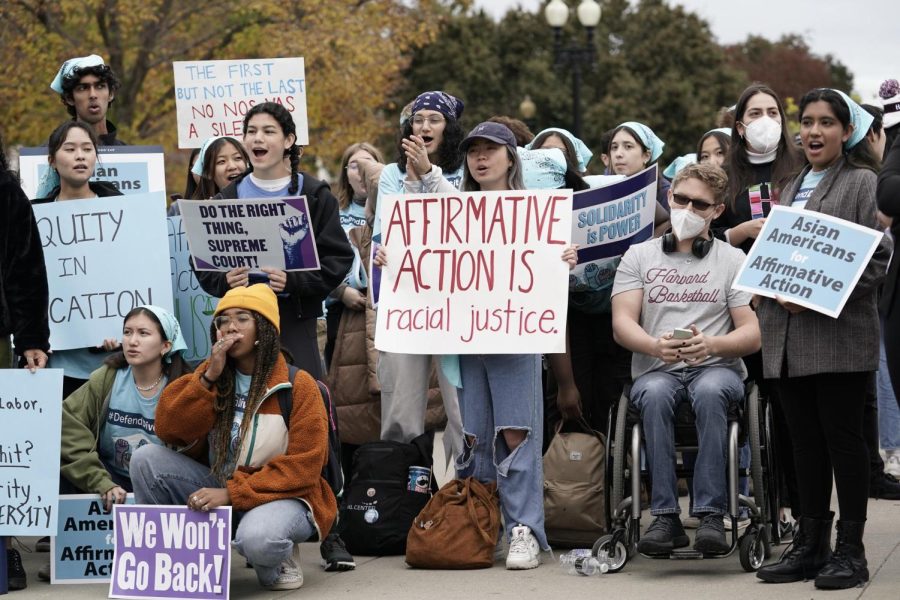How to Fix Affirmative Action
Many universities employ affirmative action, boosting Black, Hispanic, and Native American applicants. However, such a broad notion of racial diversity in affirmative action is fundamentally contrary to increasing diversity, fails to prioritize the needs of demonstrably marginalized students, and betrays the purpose of increasing diversity.
May 1, 2023
Diversity is a strength. At least, that’s what elite universities claim. To advance this ideal, many universities employ affirmative action, boosting Black, Hispanic, and Native American applicants. However, pursuing such a broad notion of racial diversity through affirmative action fails to prioritize the needs of demonstrably marginalized students and betrays the purpose of increasing diversity.
One of the most common arguments for affirmative action is the desire to correct the systemic racial inequalities that people of color face today caused by historical injustice. Jeff Raikes, for example, argues, “Ending affirmative action will only compound the many lingering and systemic racial inequities that people of color still face today.”
Supreme Court Justice Sonia Sotomayor further reiterates: “If you’re Black, you’re more likely to be in an under-resourced school, you’re more likely to be taught by teachers who are not as qualified as others, you’re more likely to be viewed as having less academic potential.” Because of structural inequalities, structural solutions must provide people of color with a pipeline to increase their socioeconomic status.
However, this raises the question: why use race as a proxy for socioeconomic status? If the primary effect of systemic racism is the relegation of historically marginalized racial groups to a lower socioeconomic status, providing affirmative action exclusively to the economically disadvantaged should disproportionately benefit people of color, thereby addressing systemic racial inequalities.
Why apply a blanket policy of privileging Black, Hispanic, and Native American individuals–even when it benefits those who have economically surpassed their white counterparts or are recent, wealthy immigrants whose ancestors weren’t subject to the openly-institutionalized systems of racism in America?
The answer is simple: money.
By cherry-picking financially well-off people of color, elite universities can simultaneously claim the clout a racially diverse campus entails while saving money on would-be scholarships, loans, and grants that compete with faculty salaries, student amenities, and overhead costs. There are simply zero economic or social pressures for elite universities to completely gear affirmative action programs toward low-income applicants. After all, why waste money on the poor when you could tout your superficially diverse student body for just as much clout?
Richard Kahlenberg, a non-resident scholar at Georgetown University’s McCourt School of Public Policy, notes that at Harvard, “71% of the Black and Latino students come from wealthy backgrounds.” Due to the zero-sum nature of college admissions, such a system largely slingshots wealthier people into even higher positions of wealth and status at the expense of providing a pipeline for low-income students to reach their academic potential.
Though affirmative action does benefit low-income people of color, affirmative action’s current form empirically fails to promote socioeconomic diversity. For instance, 71 percent of the University of Pennsylvania students come from the top 20 percent of earners. Therefore, if elite universities cared more about a diverse student body than the lip service they pay, they would zero in on affirmative action programs for the economically disadvantaged. Instead, race-based affirmative action disproportionately benefits wealthy underrepresented minorities that share far more in common in terms of experiences with their rich, white counterparts.
In support of race-based affirmative action, University of Pennsylvania Law Professor Cara McClellan contends, “Learning amongst students who have different backgrounds and experiences fosters stronger critical thinking skills, empathy, and overall knowledge, which are essential for the future leaders of a society that is becoming increasingly more diverse.”
However, the notion that a policy of specifically increasing racial diversity is a necessary proxy to promote different backgrounds and experiences so that students learn to lead and engage in an increasingly diverse society is a farce that betrays the purpose of a diverse student body. The existing failure to promote socioeconomic diversity leads to monolithic economic experiences on college campuses. A white person and a Black person that grew up in Section 8 housing likely share more in terms of experiences, opportunities, and lifestyle habits compared to their gated community peers. Therefore, if universities truly wanted to create students that can become leaders in an increasingly diverse society, universities would replace race-based affirmative action with a more robust class-based affirmative action that better encapsulates both the racial and socioeconomic experiences of America.
None of this is to diminish the present structural inequities between today’s racial groups. The racial inequities caused by hundreds of years of openly-institutionalized discrimination is an ugly reality that must be acknowledged within university admissions and American institutions alike. Nonetheless, correcting race-based discrimination with more race-based discrimination is akin to swatting a fly with a hammer. Though you may successfully kill the fly, race-based affirmative action has the side-effect of arbitrarily benefiting wealthy people who had similar, if not more, opportunities at the expense of their low-income counterparts of all races.


